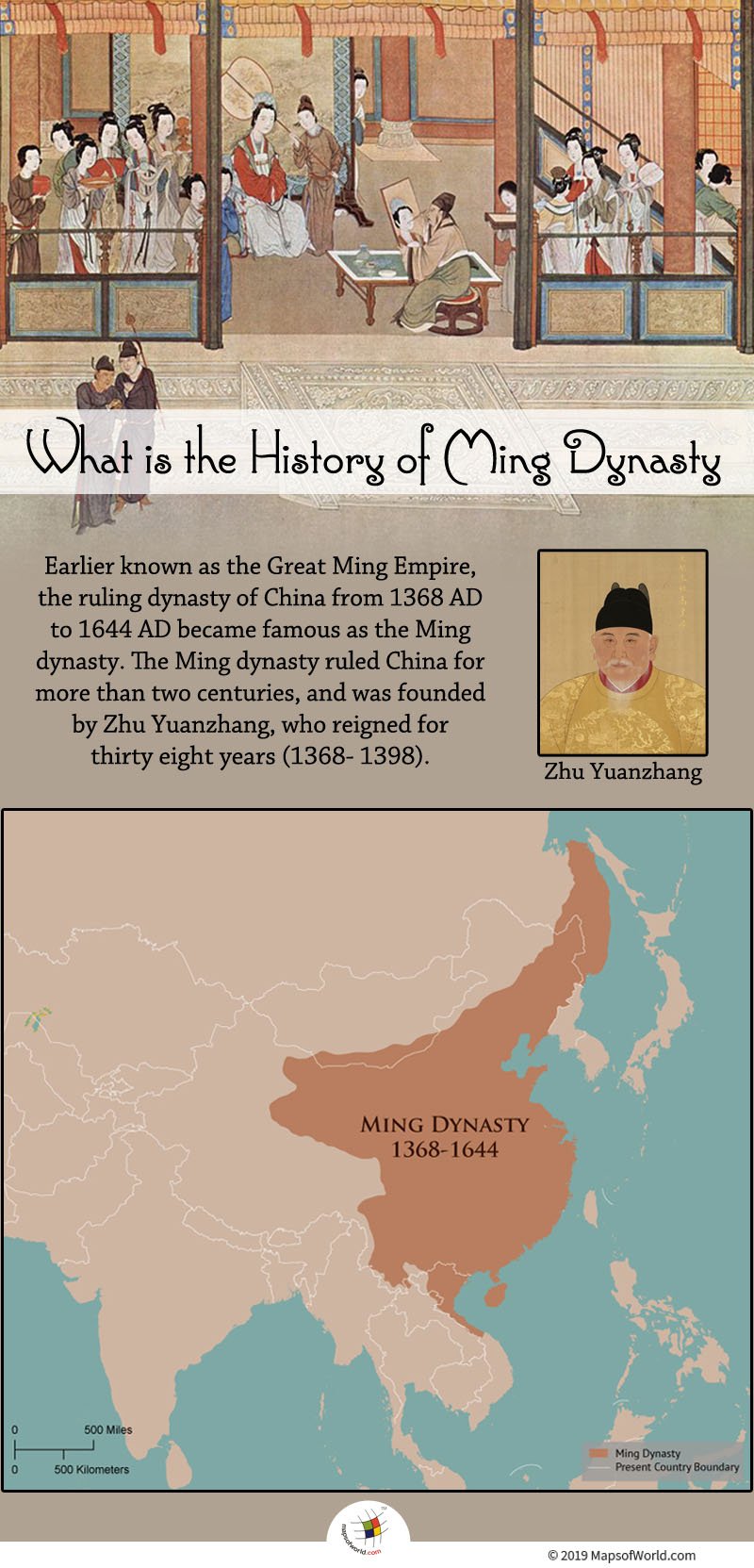

Infographic Shows Map Depicting The Ming Dynasty (1368-1644)
Earlier known as the Great Ming Empire, the ruling dynasty of China from 1368 AD to 1644 AD became famous as the Ming dynasty. It was preceded by the tyrannical rule of Mongol Yuan dynasty (1279-1368). The Ming dynasty ruled China for more than two centuries, and was founded by Zhu Yuanzhang, who reigned for thirty eight years (1368- 1398).
With Zhu Yuanzhang’s capture of Nanjing (the first Ming capital) in 1356, and the subsequent defeat of his two major rivals, Chen Youliang and then Zhang Shicheng in 1367, Zhu became a powerful leader in China. The death of Han Liner, regarded as the heir to the lineage of Song Emperors, further cemented Zhu’s position. In 1368, he led the rebel armies to overthrow the Yuan empire of Mongolian rulers. With this, he proclaimed himself the emperor, taking the name Hongwu and naming his dynasty Ming (meaning light). In the long history of China, Hongwu then became the only emperor who was born in a humble peasant family.
The reign of emperor Hongwu was followed by the reign of his fourth son, Zhu Di from 1403 AD to 1424 AD. He shifted the capital from Nanjing to Beijing in 1421 AD. In the corresponding period, Ming dynasty witnessed an unparalleled growth in China’s population and economic structure under Zhu Di’s reign (Emperor Chengzu). Subsequently, it brought forth significant architectural developments such as the Forbidden City. Other significant developments included the blooming of literature and other arts, such as the world famous blue and white Ming porcelains.
A great number of innovations took place under the Ming dynasty, such as the repair of the Great Wall of China, the deepening of the Grand Canal etc. Such stable and consistent growth during the Ming reforms paved the way for a notable increase in the international trade and economic growth. The imports of large quantities of silver from Peru and Mexico, and other such parallel trades, also helped China to deal with the widespread piracy. Meanwhile, the corresponding flourishing of food trade greatly contributed to the rise of food production and, as a result, the population as well.
The remarkable economic prosperity was also accompanied by the blossoming of art and literature. Now, there existed a richer gentry of people who could afford to spend on the leisurely pursuit of the arts, aesthetics and literature. Eventually, these pleasurable activities became a dominant symbol of the elite class.
The constantly growing graph of Ming dynasty took a downward slope during Emperor Shenzong’s reign. Most importantly, the death of the intellectual administrator, Zhang Juzheng led to the neglect of the state affairs. It also resulted in the eventual decline of the national economy and military proceedings, among others. Subsequently, in the reign of Emperor Shenzong, the Jurchen tribal leader Nurhaci started organizing his defeated the Ming army in the battle of Sarhu. The rule of Nurhaci came to be known as the “Latter Jin” regime.
The final end of the Ming dynasty happened with the coming of Emperor Weizong’s reign, the last emperor. The collapse occurred primarily due to the intrigues and corruption of court eunuchs as well as the exploitation of power within the regime. Furthermore, there now came rulers who lacked talent, skills and intellect. As if this was not enough, they squandered lavishly on building projects and architecture. Adding to this was the dominant exploitation from the ruling class, coupled with natural calamities. It even invited a large scale peasant revolt against the heavy taxes and the harsh rules of the landowners.
Finally, in 1629, there was a battle between the rebel military forces. One of the most trusted leaders of the rebel army, Li Zicheng, attacked Beijing in 1644 and founded a new regime called Dashun. This led to Emperor Weizong hanging himself in Jingshan Hill of Beijing, marking the end of the Ming dynasty.
Related Links:
The Republic of Madagascar is an island country located in the Indian Ocean, off the…
The Euro is the official currency of the European Union. It is, however, not incumbent…
There are many countries or regions that are partially recognized by the UN, have disputes…
The Alaska Statehood Act was signed into law by President Dwight D. Eisenhower in 1958,…
The name Persia may, however, only be used to refer to Iran in some contexts.…
Hawaii is an Island State in the US. It is one of the 50 states…